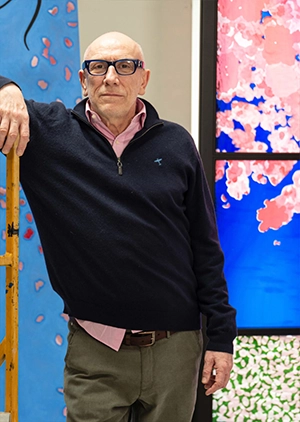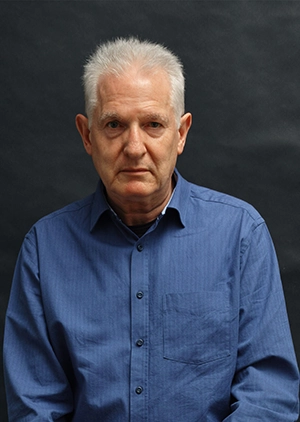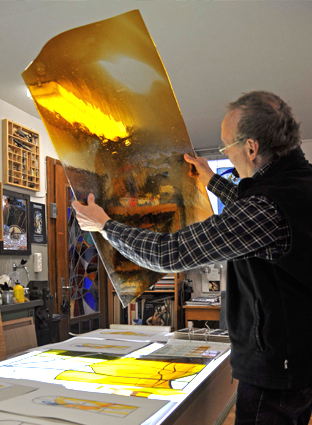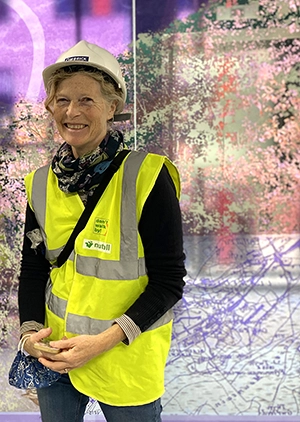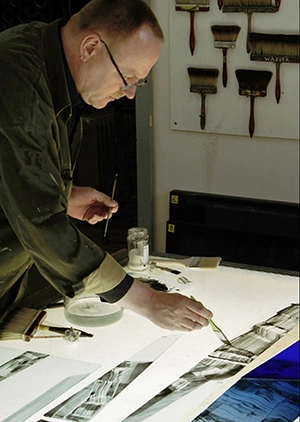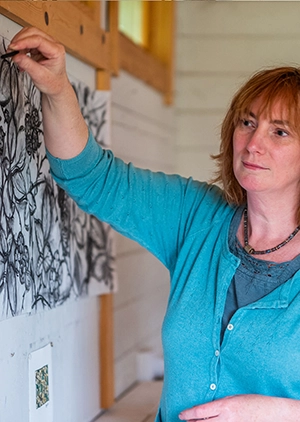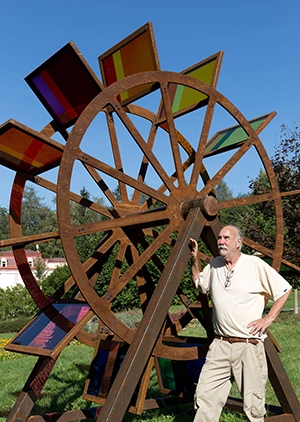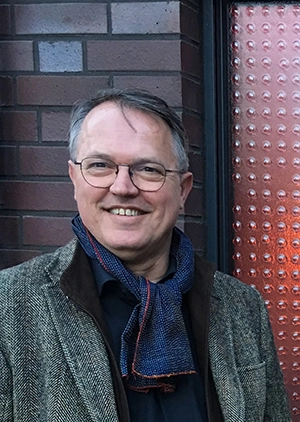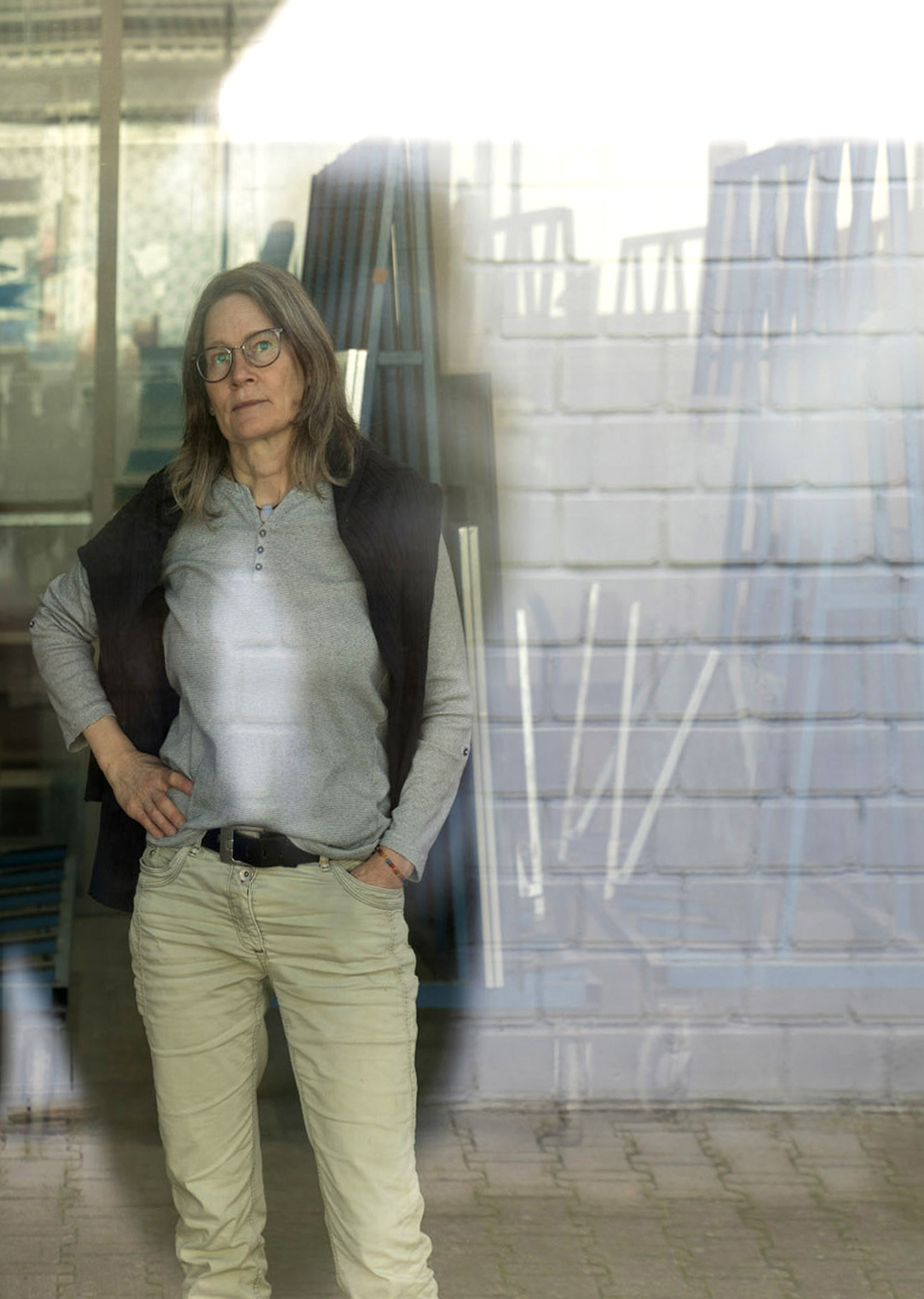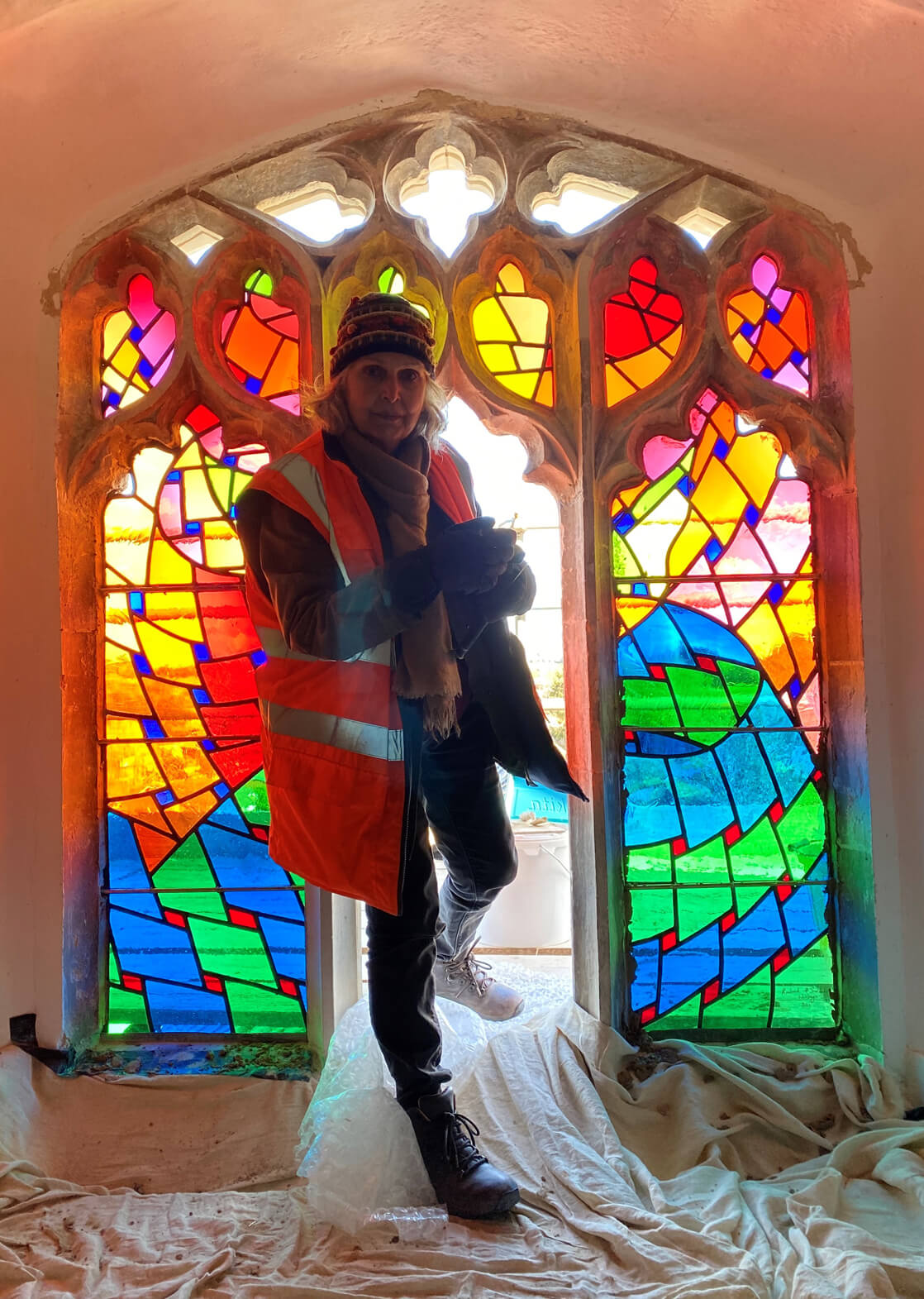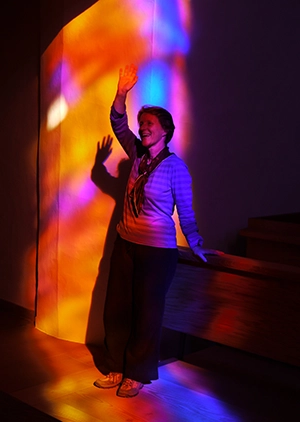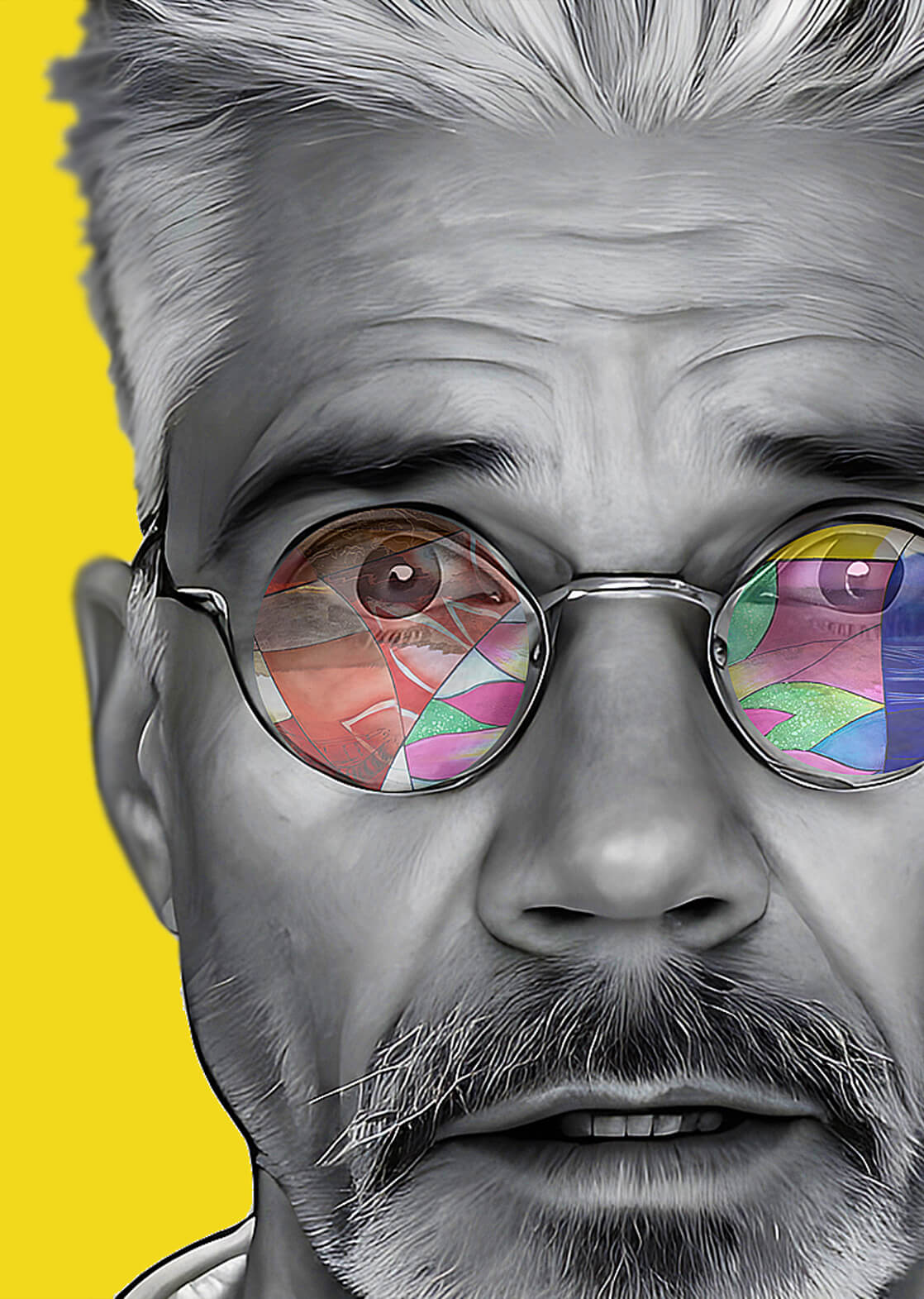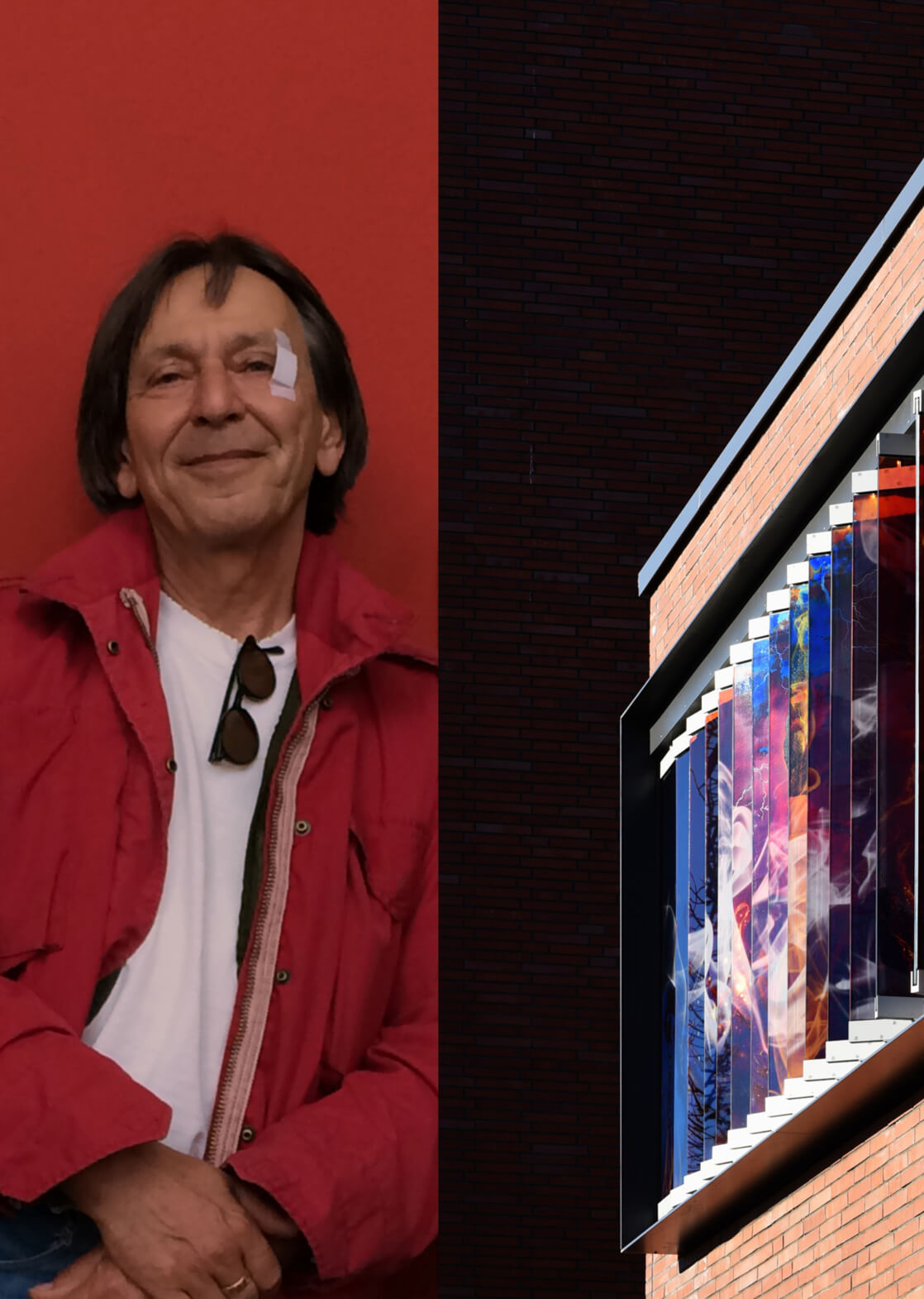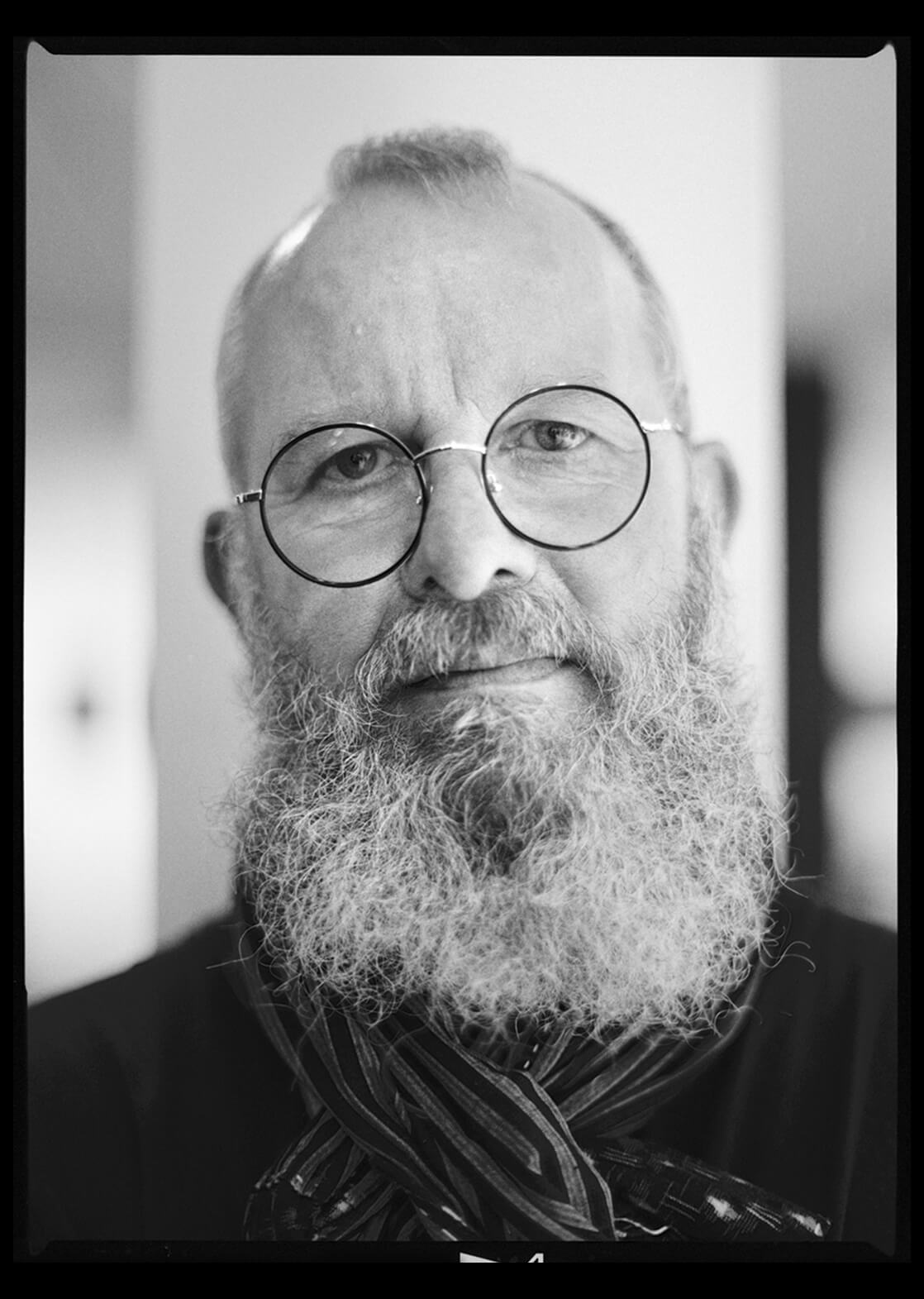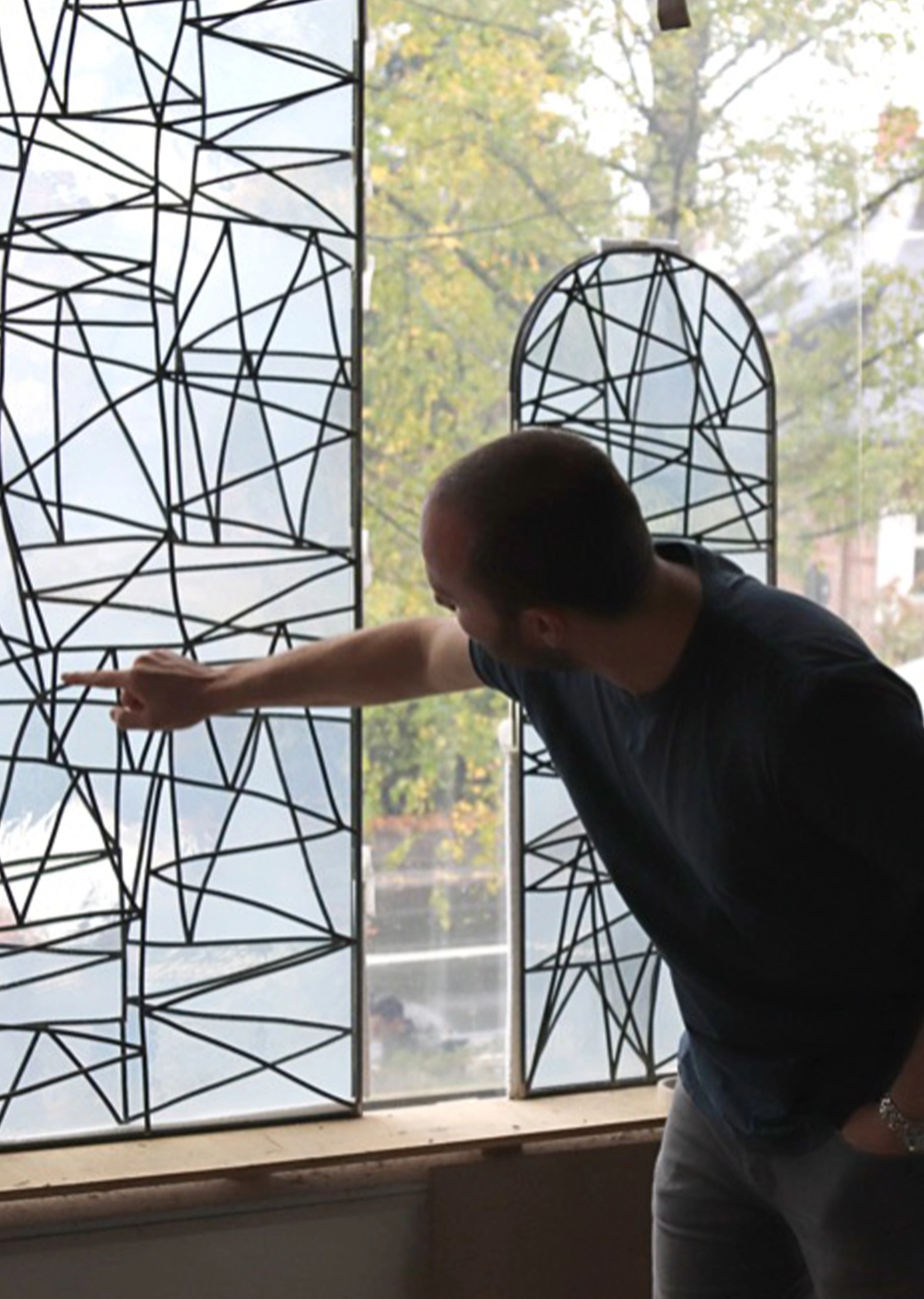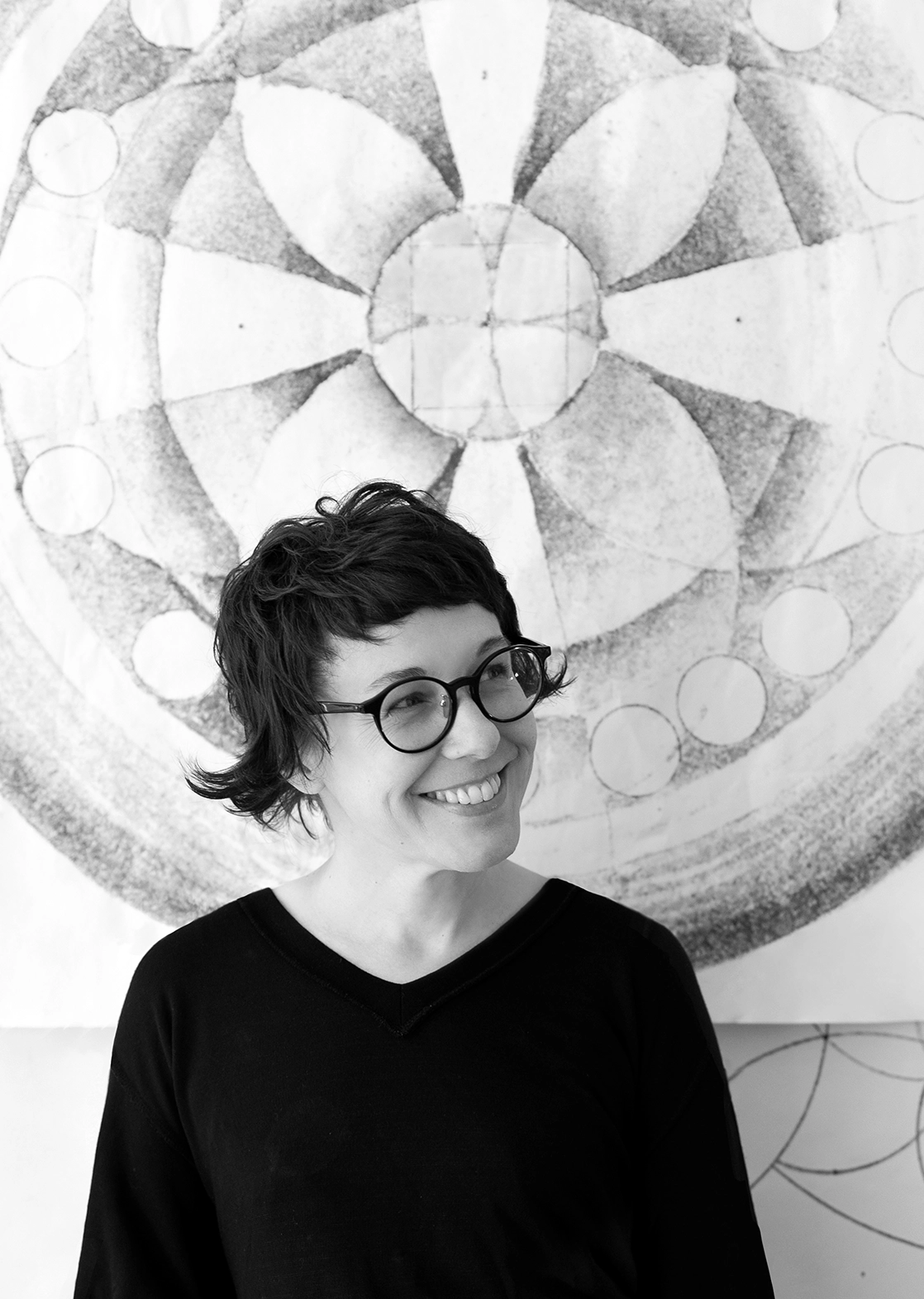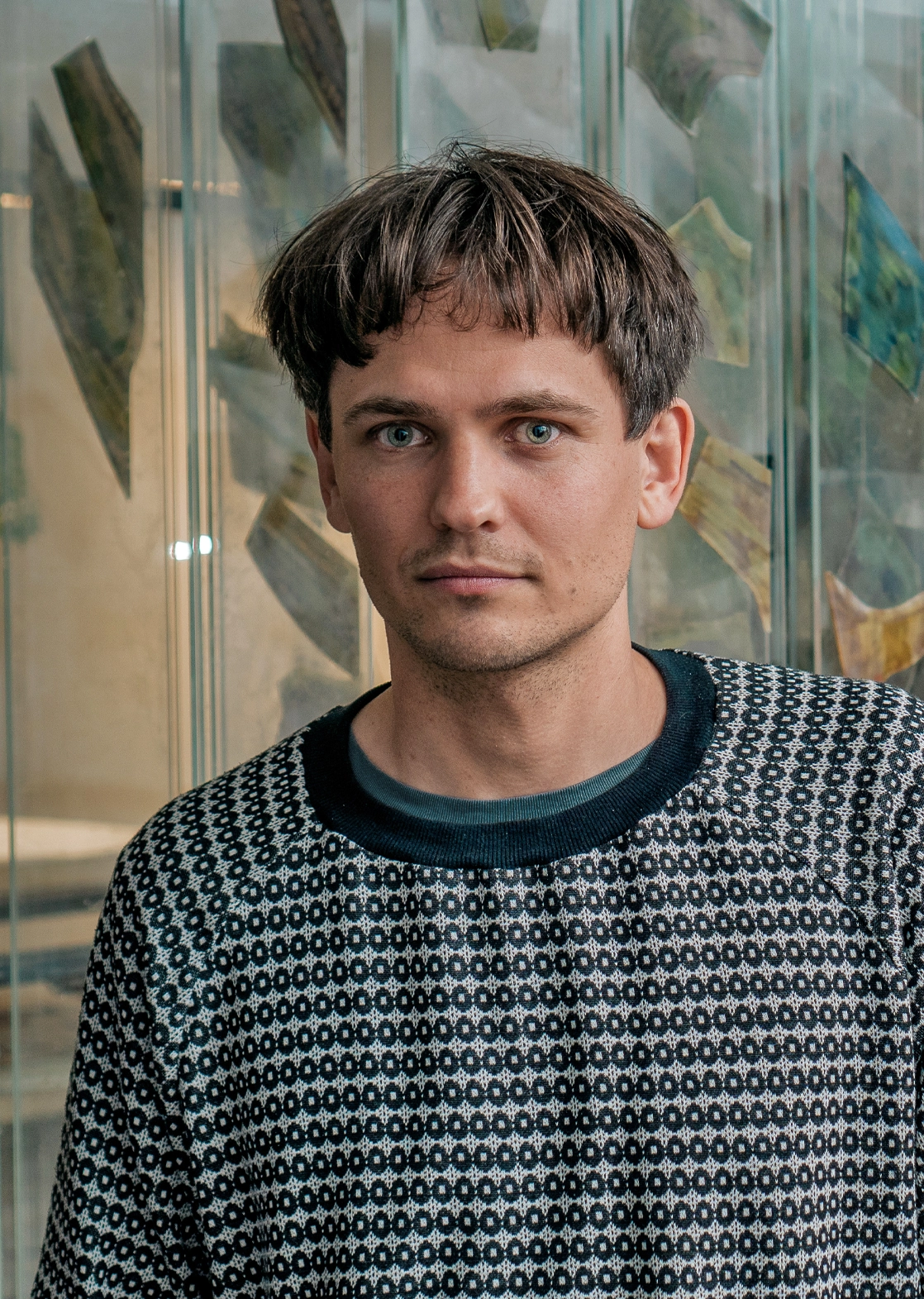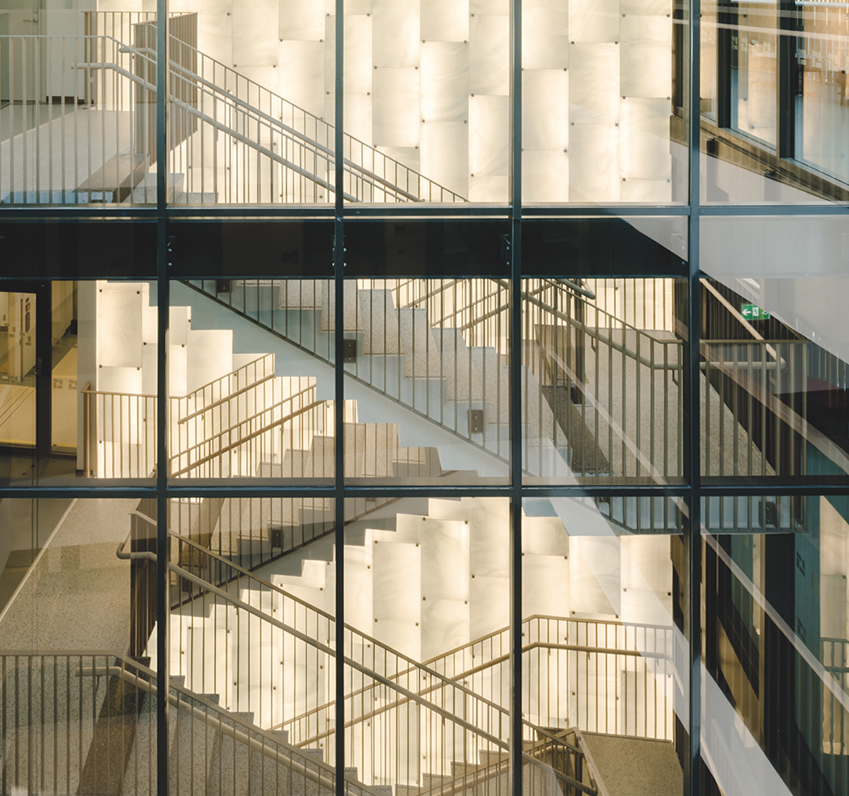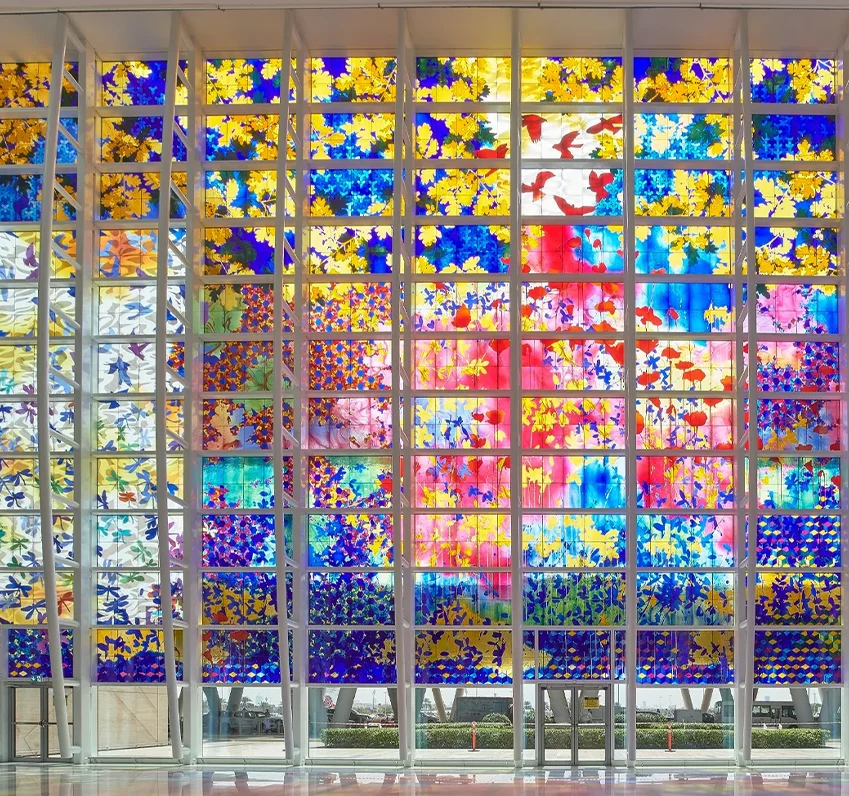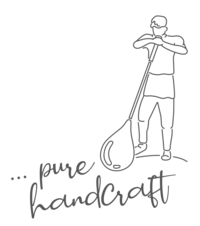I have been using Lambert’s glass for over forty years and in five continents. Lambert’s produce the most beautiful glass in the world, the most varied in range and the most artistically sympathetic to the poetry of the medium.
Brian Clarke, London 2020
Lamberts. The glassmaking company.
Glass with a soul - It's all about light
LambertsGlas® transforms spaces through glass, which acts not just as a material but as a medium that brings light, colour and life. For more than a hundred years, we have been committed to the art of glassmaking with the aim of not only designing spaces, but truly filling them with character and soul. We believe that every piece of glass should tell its own story, capture a special moment and leave a lasting impression. Our passion for excellence and meaning is the driving force behind every step of our craftsmanship.
The LambertsGlas® portfolio is known for its exceptional variety and first-class quality. It fulfils the requirements of both historical restorations and state-of-the-art design projects. With over 5000 different colours and textures, LambertsGlas® can fulfil every design wish. Whether it's vibrant colours, subtle shades or customised solutions, we offer not just glass products, but comprehensive solutions that evoke deep emotions, transform spaces into new dimensions and last for generations.

With a workforce of around 70 employees, our glassmaking company produces Lamberts-Glass in our factory in Waldsassen by hand, using a complex process. Glass is first smelted from sand, soda and lime, then coloured and finally blown into balloons. These are made into cylinders which are then reheated in the oven and finally formed into sheets.
The effort is well worth it, since this method results in the production of glass with unique properties: Small air bubbles and an uneven surface form an ideal basis for historic preservation work as well as glass art. We are not only bound by tradition but also by sustainability: We obtain our materials locally and continually invest in the improvement of our processes and our technical equipment.
The traditional method of our hand-blown flat glass production was recognised and awarded UNESCO Intangible World Cultural Heritage status in 2023.
This honour underlines the importance of our craft in world culture and is a testament to our dedication to preserving traditional manufacturing methods.
At Lamberts, we deliberately use the mouth-blowing technique because it allows us to create glass with a distinctive character. This traditional technique gives each piece exceptional depth and brilliance through fine irregularities, air bubbles and a special surface structure. Each piece bears the traces of human handiwork, making it unique. In a world of mass production, our handmade glass connects us to something deeper: a tradition that values individuality and timeless beauty. The glass reflects light in a mesmerizing way, making it a unique highlight in architectural and artistic projects. The combination of craftsmanship and exclusivity results in products that not only impress visually, but also create an emotional connection and add individuality to any space.
The Lamberts master glass blowers have preserved the noble tradition of making window glass with soul. Given that industrial flat glass has become a "non-material" in our buildings since World War II, it is a pleasure to create colored glass art with a material specially crafted by the manufacturer that has a unique character and is characterized by its properties to play with light and color.
Because I only use a limited amount of glass colors, I show the viewer the beauty of glass in its purest state. I would like to express my gratitude to the glassmakers for their care for the craft and the quality of their work.
Joost Caen
These handcrafted Lamberts glass sheets are the most beautiful in the world. They are simply the best material a stained glass artist can get.
Sarah Hall, Artist
Project: Bell Spire, Christ Church Cathedral, Vancouver
Sarah Hall, artist
My stained glass work would only be half as effective without the expressive Lamberts opaque glasses and their variety of colors. The charisma that could only be achieved with these glasses was missing.
Johannes Schreiter, Artist
Time has stood still, and centuries of tradition have found a way to meld seamlessly with modern innovation…a magnificent sight to behold, these were my initial thoughts when first I visited Lamberts glass manufactory in the early 1990s. At Lamberts, a kaleidoscope of colors of the highest quality hand-blown glass can be found. As an artist who treats glass like a canvas, working with Lamberts glass panels bring my artwork to life, making them glow like never before.
Mahbuba Maqsoodi, Artist
Colored light so sensuous and rich it will carry you away. Why design with your hands tied? Lamberts double flash is a gift from God via Waldsassen.
Guy Kemper, Artist
I work with Lamberts glass because I think quite simply this glass is most beautiful material on the planet. The sublime and flashed nuances in Lamberts glass are exquisite and move from the realm of traditional craft into what I see is the threshold of greater mystery. I love the rainbow potential for color. The energy and movement, especially in the streaky flashed glass produced directly in the furnace, has been an ideal starting point for creating the structure in my glass designs. Twice now when I have had the good fortune to take my students to Germany, we have visited Lamberts to see the amazing glass being produced. I so appreciate Lamberts hospitality.
Scott Parsons, Artist
If the material is as unique as Lamberts glass, then this supports the artistic process in a special, even essential way!
Karl-Martin Hartmann, Artist
As an architect you sometimes think you can solve everything yourself – but it was really an excellent cooperation. Our idea was in very good hands and it turned out just as we wanted.
Lotte Soborg, Architect
For over forty years I have used Lamberts mouth-blown glass in my architectural art glass commissions. Of course there is an amazing and extensive array of colours and types of glass to chose from but definitely a favourite in their standard line, which I have used extensively, is the 'stormy' opaque white and clear glass. It is a very particular glass with unique qualities that suits my needs in many ways; very adaptable for light control as well as a being great base for a variety of glass treatments. Placing a sheet of Lamberts glass on the table and cutting off the soft edges has almost become a ritual for me.
Alexander Beleschenko, Artist
As an artist, I have hundreds of different, brilliant colors and glass qualities to choose from when it comes to hand-blown Lamberts glass. I also know that the colors are lightfast for centuries to come, so I can guarantee my customers that my work will remain just as brilliant decades later shine like day one. That's why I use Lamberts glass for my glass work.
Celia Mendoza, Artist
Much of contemporary architecture emphasizes the honest expression of materials and a design approach that is responsive to the site. The inherent beauty and workability of Lamberts mouth-blown glass make it possible to extend those same principles to my installations of architectural art glass.
Paul Housberg, Artist
It is our mission to honour the past and embrace to future by creating timeless new stained glass designs and glass applications by using the traditional techniques and materials. Lamberts’ mouth-blown glass is indispensable in our projects! It inherits the same spirit. The beauty of this glass is timeless, dynamic and the key to happiness and success in every stained glass creation!
Katrien Mestdagh, Artist
Colored light are so convincing as a metaphor for all that is good and lovely in this world. It is truly a transformative material. Lamberts glass is undeniably gorgeous. It is already stunning to behold before i even touch it myself . I have been using Lamberts glass for my entire career. It's very receptive to all the ways in which i seek to manipulate glass.
Judith Schaechter, Artist
I am happy that I have been able to work with glass as a material for 30 years. The hand-blown Lamberts glass is my favorite carrier for my creative thoughts and pictures in glass. The colored overlay gives me the opportunity to create structures, depths and shapes using the etching technique. The luminosity of the colors and the structures in the glass support the implementation of a design in glass - excellently.
Rahmi Schulz, Artist
Very ambitious work is possible using colored flashed glass. The flashed layer can be processed by etching with hydrofluoric acid. The Lamberts glassworks in Waldsassen in the Upper Palatinate produces it in high quality and with a wide range. I use this glass in all my work. There is no substitute for it, anywhere in the world. My projects could not have been realized without the glass from Waldsassen.
Karl Heinz Traut, Artist
Lamberts mouth blown antique glass is without doubt the most beautiful hand made glass in the world.
Martin Donlin, artist
Glass is my passion - there is hardly any other material that shapes itself so wonderfully.
It feels more like a very high quality brocade to wrap yourself in. The luminosity and brilliance of the colors guide me through the artistic design and implementation of the glass art.
Anyone who has ever inspired people with this material will understand why Lambertsglas can be a life's work.
Katrin Engel-Meyer, artist
I have been using hand-blown Lamberts glasses for 57 years. The quality of the traditional production, as well as the brilliance of the colors are unique in the world.
Every delivery of the special flashed glasses from your glassworks is always a special and exciting experience for me.
Fritz J. Dold, glass painter
Lamberts’ glass is simply beautiful. Each sheet is unique, and the brilliance and richness of the glass are exceptional. I love the colour, colour variations and subtle movement in each sheet which create an ever-changing quality of light and continually transform a space.
I was lucky enough to visit Lamberts’ Glass and see the skill of the master glassblowers first hand. It is a process and sight to behold. Thank you, Lamberts, for creating the most gorgeous glass!
Grace Ayson, Artist
Painting with glass is painting with light.
The painting surface glass seems immaterial. The hand-blown glasses from Glashütte Lamberts are exceptional. In a unique way, they offer the irrepressible light a forgiving membrane through which it is able to communicate with us in a wonderful way.
Thomas Kuzio, Artist
I absolutely depend on Lamberts glass in my work. I use a great deal of acid etching in my windows, and I have long considered Lamberts flashed glass extraordinarily good for this purpose, with its thin, workable flash and its subtle shift of tone across the sheet. And then, of course, the range and beauty of colour is unsurpassed. I also enjoy memories of the dramatic and atmospheric Glassworks at Waldsassen, which enrich the experience of using Lamberts glass.
Tom Denny, Artist
The hand-blown Lamberts glasses breathe. Every single glass has a soul and holds numerous secrets. Discovering these and including them in the artistic design process is extremely attractive. The diverse colors of the glasses ignite a wonderful magic and exude a joyful energy. Working with this material as an artist is wonderful. Through various etching processes of the overlay, my brushwork could be tactilely displayed on the glass. Dealing with the Lambert glass is like painting with light. In my 24 square meter glass painting "Celebration of Life", which was developed from 120 glasses of Lambert glass, color sound spaces have emerged that captivate the viewer and amaze.
Ursula Jüngst, Artist
I first became aware of the wonderful qualities of Lamberts Glass when I was a student, at Swansea, after visiting so many iconic pieces of glass in Germany, all using this glass so expertly. At the first opportunity, for my first two public art commissions in the UK, I turned to Lamberts who, to my delight, agreed to make colours to my own specification just for these commissions. I particularly love to use the double flashes and the subtleties of the opalescent glasses.
Catrin Jones, Artist
Lamberts mouth-blown glass is the best an artist can use. Lambert's reamy, opal, and antique are particular favorites that have inspired me over the years from the smallest painted detail to major architectural installations.
Ellen Mandelbaum, Artist
Centuries of tradition and many years of experience are irreplaceable when it comes to glass production.
Both make the Lamberts glasses light up, which is why I have been using them enthusiastically for over thirty years.
Gerlach Bente, Artist
Lamberts glassblowers are masters of their craft. Their incredible range of beautiful colours, with depth and sparkle, provides a wealth of opportunities for glass artists. Whether the glass surface is painted, etched or pure, Lamberts glass brings my works of art to life through light.
Helen Whittaker, Artist
As a color painter, I naturally love colors - colors as pigments, out of bottles and tubes, as radiantly luminous surfaces on pictures. The highest increase in color is colored glass – the light IN the color is unbeatable. And with Lamberts glasses you climb to the top of the color summit. With this color, the view into the distance and depth is breathtakingly beautiful!
Jörgen Habedank, Artist
Daylight from the outside through glass painting penetrates into the interior of the room, can increase the power of the colors into something magical. It was something special for me to work on mouth-blown glass with amorphous characteristics.
Max Uhlig, Artist
I like using Lamberts mouth blown glasses because I know I can rely on the quality of their range. The variety of available hues in both pot-metal and flash glasses means I can design with confidence, knowing that the glass I need for any given project will be available. Lamberts glasses are so much more than just the colour. The refractive qualities make them a delight to work with.
Petri Anderson, Artist
Visiting Lamberts and selecting beautiful glass from their vast glass racks is one of my favourite things ever. The range of colours and textures makes the choosing very difficult. I love seedy glass and last time I was there I found a particularly beguiling blue-grey seedy flashed glass that sparkles like the sea I was depicting. The Master blowers are able to produce glass that is uniform in thickness and easy to cut - a gift for the stained glass artist. I can’t wait to return.
Rachel Mulligan, Artist
Even as a student at the Academy of Fine Arts in Vienna, I was looking for the strongest pigments and colors. When I first saw the hand-blown colored glasses at Lamberts in Waldsassen, it was like magic for me. Blue, red, golden pink, golden ruby, selenium orange... in the purest clear beauty, like jewels. From then on I dedicated myself to glass art and created great works of art all over Europe.
Tobias Kammerer, Artist
I’ve worked with Lamberts mouth-blown glass for over thirty years and I can still be reduced to tears on receiving a new delivery and holding it up to the light. It is without doubt my ‘go-to’ for colour. It’s brilliance, luminosity and refractive qualities are unsurpassed; while subtlety in tone and movement is there when needed. Whether it’s used in new or restoration work, painted, acid-etched or stained, there isn't a better quality of sheet glass out there. It’s a pleasure to handle and cut. I find the trick these days is to not be afraid of its beauty; to work with it while not compromising it.
Simon Howard, Artist
It's so great because it's plastic. It's not just printed on it, it's a body. It's really great!
Thomas Bayrle, Artist
It is a feast for the eyes when the hand-blown Lamberts glass responds in lush colors under the light of the sun. Nothing else can! So it should now be seen, experienced and enjoyed by many passers-by! For that alone, the work - the time and effort of all those involved - was worth it!
Detlev Bertram, Artist
For nearly 45 years I have worked with Lamberts Glass. It still makes my heart throb! The wide range of visual organic marks of seeds and striations, bold and subtle color shifts along with tonal variation in Lamberts mouthblown sheet glass allow me to keep my designs full of life while being light and airy. I most enjoy working with Lamberts flashed glass thanks to its ability to accept layers of dimension and movement by utilizing various artistic processes. Blown sheet glass is in keeping with my artwork that is made with my heart, mind and soul with a connection to nature. It’s all about working with glass that reflects and transmit true color to spark an emotional experience with my glass designs.
Nancy Gong, Artist
Lamberts Glass is the purest and truest representation of the magical qualities that distinguishes glass from any other material. Their super skilled master craftsmen use the well-established ancient method and are able to produce glass sheets, that are masterpieces in their own right. I’ll be forever in awe of the vast spectrum of colours, optical effects and inclusions within Lamberts Glass that deliver beautiful inner refraction upon the passage of light when the glass appears to be completely alive. As for any artist, the choice of my ‘canvas’ forms an important start to my project and a vital part to my creative journey bringing my designs alive. The beauty of Lamberts Glass is simply what the world of art glass cannot live without!
Elizabeth Sinkova, Artist
It is heaven on earth that the great tradition and masterly skills of the Lamberts glassworks enable us artists to create the fantastic basis for re-creation in the spirit of the Holy Spirit. A thousand thanks to the Lamberts glassworks and all the hard-working hands.
Johann Weyringer, artist
THE COLOR DIVERSITY, THE COLOR DEPTH AND THE BRILLIANCE ARE SIMPLY UNBEATABLE! Thank you for your great work!
Lea Dievenow, artist
Over the years I’ve preferred to use Lamberts glass due to its consistency of colour and texture,and also because it cuts, paints, Staines and etches well, I’ve also found that if a colour isn’t available from the UK stockiest the factory well go above and beyond to produce a glass that suits my requirements.
Jon Calan, artist
Glass was brought to me. With the wonderful mouth-blown glass, in various colors and I dreamed in front of the glass panels. My childhood became a daily festival. I listened to Haydn, Mozart, Beethoven and the rock music from the mouth-blown glass. The fascination has also transferred to my paintings, my painted pictures are transparent to opaque and always in motion. I admired the glass blowers how they give every glass panel their own character. Hail the lamberts glass!
Hella De Santarossa, artist
The Lamberts glassworks in Waldsassen. What a wonderful place. It is worth more than just a trip. Being there is a must. I always enjoy going there with a group of students from the Munich Art Academy. The production and quality of the glasses, the friendly reception, the unique advice are always impressive: Colored glass for art! Only Lambert's glasses could offer the variety and quality of the approximately 40 colors required for my 2020 project in South Korea. Thank you very much!
Thierry Boissel, artist
Thanks to Lamberts glass, I was able to translate my bold colour pallet from murals and canvases into beautiful and brilliant glass installations. Thus, they made the seemingly impossible possible. In addition to this, every piece of Lamberts glass has such a quality in the material itself, that it brings an extra layer of life to my glass works.
MadC, artist
For many of my projects I use mouth-blown Lamberts glasses decisive for the overall effect - e.g. in the chapel at Frankfurt Airport or at the chancel windows for the Regiswindiskirche in Lauffen. Ultimately, there is no more beautiful glass - the "Intangible Cultural Heritage" award by the German UNESCO Commission in 2015 is logical and absolutely appropriate.
Angelika Weingardt, artist
I always pay meticulous attention to detail in all our projects and with the great team at Lamberts, I can discuss my requirements in depth, carefully balancing the intensity or lightness of each colour to achieve the subtle qualities of light and radiance that can make magic happen.
Surinder Warboys , artist
When I discovered the Waldsassen glass a few years ago, in Heidelberg with the master glazier Bernd Bury, it was all over me. For a week I was drunk from this beautiful, noble material. The window designs I make with this glass are an invigorating and regenerating work every time. It's just nice to look into real colors that really vibrate as a counterpoint to the superficial, digital color spectrum. I thank the people of Waldsassen for their dedicated and masterful work!
Maria Theresia von Fürstenberg, artist
https://www.atelier-fuerstenberg.
With the Hønefoss kirke (Norway) commission, I found that I composed my colour palette entirely (and spontaneously) when choosing Lamberts glass. I had no need to emulate my designs or sketches, as I could not have imagined the real nuances in the glass. Apart from cutting it, there was no need to do anything to it. The colour, texture and movement in the glass is enough in itself.
Peter Sutton, artist
Lamberts glass is the brush that makes it possible to create works in the medium of light.
Bernhard Adams, artist
Lamberts glass is amazing. It is the perfect base to materialize my ideas in glass. Using something so exquisite from the start gives a great advantage. Working with Lamberts glass makes artistic pieces unique and beautiful.
Sofía Villamarín, Artist
Lamberts mouthblown glass is a fabulous and unique range of glasses for the architectural glass artist.
I first saw Lamberts glass as a student in 1977, while on an Ontario Crafts Council sponsored tour of post war stained glass in Germany. Uniquely memorable and influential were Ludwig Schaffrath’s Cloister windows for Aachen Dom. This way of working with reamy and seeded clear glass, in which the environment beyond the window creates the dynamic of the visual experience, was very impressive. That and the use of the leadwork as drawing was particularly striking and influential. On the same trip I was also impressed with the opak colours used by Johannes Schreiter and Georg Meistermann. The way in which the glass soaked up the light and was saturated with colour in Schreiter’s work affected me deeply. Also, the eccentric and witty Meistermann’s opened up new worlds of expressive possibility for me. This was a revolution in stained glass design that was to have profound influence at Swansea College of Art, in Wales, where I was studying. A revolution in design and glass use which seemed to totally pass by the English studio tradition, but inspired a generation of international designers in Architectural Glass coming out of the Welsh school, myself among them.
My first public commission, was while artist in residence at the European Centre for Folk Studies in Llangollen, and I used Lamberts glass throughout the triptych. The window takes as its theme and background, the humble ruled notebook page, combined with runic text, Europe’s first written language.
I was influenced by Schraffrath’s use of opal whites, transparent figured glasses and leadline drawing, in a window I designed for Missenden Abbey in 1988. I used Lambert’s reamy and echt antique in other windows throughout the abbey as well. I used Lamberts glass for a window in the entrance area, where I included historic renaissance roundels from the Abbey. These were fortunately saved from the fires that ravaged the building in the early 1980’s.
Years later while doing works throughout the Grand Theatre in Swansea, Wales, I had the pleasant experience of having glass made to my colour specifications. This was a great experience because I was able to visit the factory in Waldsassen and was very impressed by the welcome, I received. It was tremendous watching sheet glass being made. An added pleasure afterwards was finding more sheets of the colours I had ordered in the stock at Bendheims in New York (Passaic); all identified with my initials DP 1 through DP 6; a range of transparent blues and bluey greens.
Later, on a project for the Sisters of Providence Motherhouse in Kingston, Ontario, Canada, I created works for all the windows in the Motherhouse, using opal whites from Lamberts, to create a meditative atmosphere for the sisters.
I love the range of glass that Lamberts produces and the quality of making that makes cutting and handling easy and reliable. Much of the above work was made in my studio in Swansea, but I also had the pleasure of using Lamberts glass on projects made at Derix Studios, Taunusstein. The dining room window at Missenden was made there. As was my public commission for the Channel View Centre in Cardiff, Wales. There I used Opak colours in the suite of windows to recreate satellite images of the United Kingdom. Later, in a project made in my Swansea studio, I combined Lamberts glass with dichroic fliters and cut metal sheet, for the Tower of The Ecliptic, a public observatory in Swansea, Wales. Many of these works have been published; The Tower of the Ecliptic appears in Robert Kelhmann’s ‘Twentieth Century Stained Glass – New Directions’
David Pearl, Artist
I first used Lambert’s Glass in the spring of 1975 for a window that I was designing for the artist Dave Peterson. It was to be situated in an aperture in a mediaeval stone wall between his kitchen and living room. I was using spectacle lenses, staining them and setting them in lead glazing.
As a student in the Architectural Glass Department in Swansea Art College. I had heard of the qualities of opal glass made in Germany and decided that was exactly what I needed: to juxtapose the magnification of the lenses; to partly obscure the view through; to make the most of the low natural light available; to allow the Peterson kids to play with peering through the magnified lenses; but only glimpse an intimation of the total view.
I set off to drive to Germany with my then boyfriend, as far as Hilden, to purchase glass from Becker’s. Having crammed a crash O-level course in German, I was slightly disappointed that everyone at Becker’s spoke excellent English. The range of luminous opal and opak glass available did not disappoint, it enthralled me. I was fascinated by ‘milch und wasser’,the glass that looks like swathes of milk floating on water. The window that I made with it was called ‘From Icarus to Alex’ which was dedicated to my hairdresser who died hang-gliding above Rhossilli beach. Eventually it was bought by the Victoria & Albert Museum in London.
On the same trip I visited Ludwig Schaffrath in Alsdorf-Ofden. The following year I worked with him for six weeks and we became lifelong friends. He really taught me the value of Lambert’s glass. This knowledge, I would in turn, pass on to my assistants – giving them small samples of white opal and opaque glass and asking them to sort it, in a row against the glass easel, to differentiate the differing densities. At first, to their puzzlement, it all appeared the same, but gradually it became apparent, that each was subtly different.
In the early eighties, my Unilever Headquarters windows in London made good use of Lambert’s ‘opak’ glass, since they were internal and lit by a light well. Stained glass usually lives or dies by the quality of light it transmits. However opaque glass still holds its colour to some degree under surface light. Part of that scheme has recently been removed, but it lives on in Japan, in a private collection.
My Unilever commission was fabricated by the Derix Studio in Taunusstein, as were the 200 metres of glass for Royal Exchange Theatre two decades later.
Around the millennium, I worked with Peter’s Studio in Paderborn on the lower panels of my design for Sheffield Cathedral Lantern; they sandwiched two etched layers of Lambert’s glass to achieve my painterly watercolour design.
Subsequently, I used the same technique when Lambert’s asked me to design a window for their factory. I had a wonderful time drawing the teams making the glass, animated by the almost alchemical staged theatre: of pulling molten glass from the furnace on the punty; and blowing it into muffs. The window is testament to that glorious, energetic excitement.
Amber Hiscott, Artist
One of my favourite parts of starting a new commission is choosing the perfect glass, and the quality and variety of Lamberts Glass is exquisite and unrivalled.
It brings me so much joy to spend time picking the ideal combination of colours and textures from their impressive collection. Awesome Glass!
Derek Hunt, Artist
Glass, one of the highest cultural achievements of mankind, handed down and brought to perfection by the unique, hand-blown flat glasses, which the highly specialized people of the Lamberts glassworks bring into the world. It is moving to be able to work with this material, which is inspired by skillfully powerful breathing. This allows me to implement my artistic intention in a colourful, luminous, translucent way that connects the inside and outside in a way that is not possible with any other material. The interplay of colored, transparent glass and constantly changing light creates living works.
René Blättermann, Artist
I have had the great privilege since 1988 to have worked with the mouth-blown glass of Lamberts Glass.
In that time I've had the pleasure to visit the factory and watch the production team at work. It really was an amazing opportunity to see. I am crazy for the infinite range of colors available from Lamberts and particularly love the rubino glass. I also am routinely drawn back to their restoration, genuine antique, and milk glasses for their simple beauty.
Depicted here is the largest public glass project I've made thus far: the stained glass rose window for the Eldridge Street Synagogue and Museum in New York City .This project was made in collaboration with architect Deborah Gans as a celebration of the historic synagogue built in 1887. The window is filled with field of stars set against two layers of Lamberts blue tinted mouth-blown glass which they specially made to our specification. These glass pieces were adhered to large panels of industrial glass using a silicone adhesion technique making this the first large stained glass window of its kind to be produced in the United States.
I hope to work with Lamberts many more times in the future.
Kiki Smith, Artist
It is important to me to illuminate the secret meaning that is invested in us through painting. Immediately, the glass is always the medium that fascinates me, not to create images, but to dwell in the likeness of the transcendent in me and in everything.
Erich Schickling, Artist
Through my stained glass, especially through my grinding technique, I want to shape the light with respect. There is no more suitable material to bring the "banality" light, the "nothingness" of light, the light as a phenomenon into the consciousness of people. It shines through the flashed glasses I work on and comes out on the other side, depending on the processing, as something completely different. As a result, the work and the hand-blown antique glass from the Lamberts Glassworks radiate dignity. The glassmakers can be proud of this. Without their skill, my work would not be possible in this way.
Uwe Fossemer, Artist
I have enjoyed working with the extensive colour range of Lambert’s glass.
So many possibilities. Working with coloured hand blown antique glass makes me so happy.
Fiona Tan, Artist
For more than half a century I have had the great privilege of incorporating Lamberts Glass into many of my projects.
I have come to rely on the majestic beauty of the glass to elevate each work with its purity of color and richness of structure to heights of visual poetry.
The Orlando Federal Courthouse is just such an example. The richness and complexity of Al Held’s compositions were so magnificently seen in their expression with Lamberts Glass.
It was Lamberts Glass that transformed a phenomenal work of glass into a classic work of art for the ages.
Kenneth von Roenn, Artist
Lambert's flash glass is an ideal canvas for artists; transmitted light creates continual movement and transformation through subtle colour, textural and tonal variations. The craft involved in making a stained glass panel goes through many hands and traditional processes. From the fiery furnaces and skilled glassblowers, to the artists and designers and onto the glaziers trusted hands installing them. All these traditional techniques are passed on and these practices are kept alive for future generations.
Natasha Redina, Artist
I’ve been working in stained glass for over forty years and Lamberts glass is the glass I have always depended on. There is no color they can’t make. I have sent them samples where I taped two pieces of glass together to make a new color and they made it. I have visited the factory. What you see there is a team of artists in their own right working together to create beautiful glass. It is like watching ballet. I revere their work, their product, and their creativity. Thanks, Lamberts!
Rick Prigg, Artist
I've been using Lamberts' glass for several years and for me it's an authentic dissemination, an emanation of colour, an intrinsic material of light, a spark of life. Each glass has a unique character, I like to match the glass in its original character and with its delicate nuances, to create. The production process is noble and the light colours are rich in tones that fill the space with ever new breaths. In each situation, the light shines in infinite magical colours, invading the space and resulting in creativity in an ever new, mystical and ascetic process.
Dina Figueiredo, Artist
The individual shapes and surfaces of each individual pane of glass have a mysterious vitality. Preserving this character and taking up the irregularities as an element for my work without cutting the pane beforehand was a great technical challenge in the realisation, but essential for the result.
Louise Lang, Artist
I came into contact with glass as a material early on during my work placement in year 9 at the Baetzel art glassworks (Kunstglaserei Baetzel). There I also got to know the great glass designer Wilhelm Buschulte.
We visited the glass manufactory Lamberts with both the Hadamar glass school and Ludwig Schaffrath, at night of course - an unforgettable experience!
To this day, I still work with the mouth-blown glass from Lamberts, whose colour nuances, strength and vibrancy absolutely win me over!
Katja Ploetz, Artist
I have been working with the wonderful black glass from Lamberts for over a decade. The texture of the glass, its soft, almost velvety surface, gives my photographs a unique aura. The vibrations of the silver, the deep black and the texture of the glass give my works an almost three-dimensional feel. I am glad that the Lamberts glassworks exists, which produces my black glass to such a high standard of craftsmanship. It is a pleasure to be able to work with it.
Steffen Diemer, Artist
...every morning brings the new light and lets a colored window shine again in all the colors of creation, light up, bring it back to life. Solid matter dematerializes in the light. And this is a mystical phenomenon inherent in glass. The inside merges seamlessly into the outside. To be interpreted as a symbol for the intangible and difficult to imagine transition from matter to spirit, from spirit to matter. And that is the great spiritual potency of glass.
I find it realized in the wonderful glass from the Lamberts glassworks.
Ada Isensee, Artist
Images are wordless thinking. Images are the crystallization of inner tension. Under certain conditions, the image can be language (communication) - and the word can become the image.
Pictures, and of course glass pictures too, can render wordless - say the unspeakable - move and change thoughts.
My stained glass windows would not have been created without the wonderful mouth-blown colored glass from the glassworks.
Hans Gottfried von Stockhausen, Artist
The fascinating color palette of the glass, the special atmosphere of the refracted light and the intensity of the colors make the work of Lambert Glass special and unique.
Undine Bandelin, Artist
In the Lamberts glassworks in Waldsassen, true treasures are created in an archaic and hot place, similar to a witch's kitchen, in a manufacturing process that seems to come from another world and is characterized by traditional craftsmanship and ancient knowledge. In addition to the brilliance of the colors, which cannot be adequately transferred to any other material or medium, this process also plays a role in the value of the material, making each sheet unique.
Sebastian Pless, Artist
I work with Lamberts glass because of its handcrafted quality, impressive colors and excellent light transmission.
The preservation of traditional craftsmanship is an important aspect of my choice of material.
Thanks to its wide range of transparencies, genuine antique glass great flexibility for new artistic works in an old garb.
I also appreciate the sustainable production and the reputation of Lamberts-Glas, which gives me the security of creating long-lasting and
high-quality works of art.
Robin Zöffzig, Artist
The roots of my work lie in the space between painting and film, and the theme of light is fundamental to both. This year I started working with glass and am overwhelmed by the effect and expression of the mouth-blown glass from Lamberts. As an artist, you should only ever work with the very best materials, looking far into the future, towards eternity. The intensity of the color experience of Lamberts mouth-blown glass will always be the same, even centuries from now.
Boscher Theodor, 2024, Artist
Coloured Lamberts glass is a space where photons and electrons are orchestrated in a symphony. It is a perfect instrument that helps to extend my vision, discovering something new.
Oksana Kondratyeva, Künstlerin
As a visual artist, I have been working closely with LambertsGlas and Derix Glasstudios since 2015. For me, light is the essence of painting, its origin, its existence and also its goal. The realization of my ideas in glass is therefore very easy for me. The choice of colors, materials and the outstanding quality of the glass allow me to make precise color decisions with ease, combine them with ancient and modern glass finishing methods and thus complete a work of art full of warmth, depth and glory in light. Light is a person and these wonderful colored glasses are made by exceptional craftsmen and women for artists, art and society. A cultural asset that benefits everyone.
Jakob Lang, Künstler
Glass is so well suited to art because of its ambiguity, it reflects, absorbs and lets light through, it appears almost incorporeal and yet is hard and heavy. The extremely durable genuine antique glass from Lamberts adds colorfulness to these aspects and, last but not least, an exciting liveliness from the handcrafted production.
Thomas Medicus, artist
Working with Lamberts is a real enrichment for me. I appreciate not only the exchange, but above all the possibilities that the unique Lamberts glass offers me. It is a special material – and I love working with it.
Anne Knödler, artist
The best stained glass begins with high quality glass, and the most effective I have found is Lamberts mouth-blown. The colours of their glass can be rich, sumptuous, and vibrant or soft, subtle and streaky. They really come into their own when sun light streams through. I use exclusively mouth-blown glass for all my public commissions and have always found the quality of the glass – and service – from Lamberts to be second to none.
Moira Malcolm, artist
We produce glass according to individual customer requests and are able to deliver more than 5000 colours.
Our particular specialities are the following glass types:
- Genuine antique glass
- Flashed glass
- Streaky glass
- Opal and Opaque Glass
- Goethe glass - colored
- Reamy-Glass
- Crackled glass
- New antique glass
- Restauro® - window glass
- Restauro® UV - protection glass
- Restauro® IR - protection glass
- Genuine rondels
- Plate discs
- Crown Bullions / Glass
- Table-cathedral-Glasses
- Hand-cast glass slabs
- AL-Wall Lite
- Wall lamps and floor lamps
- Silvered / mirrored glass
- Insulating glass

Lamberts Glass stands for high brilliance, a unique brightness, a subtle and yet unique structure as well as high quality and cutting ability.
We produce glass according to individual customer requests and are able to deliver more than 5000 colours.
Interested?
Contact us.
PORT
FOLIO







